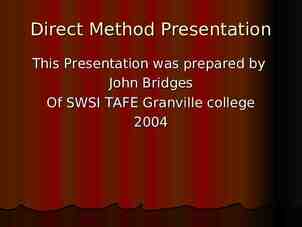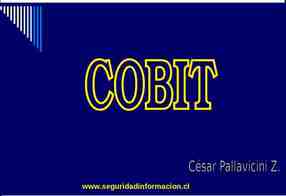Admitting Social Media Evidence
47 Slides2.58 MB
Admitting Social Media Evidence
Starting Off With the Final Product Insert video of Dan “I sure hope not”
Getting a “Writing” into Evidence Overview
The 5 Steps to Admitting Writings Form of Question Did the attorney ask a question? If so, was the form of question objectionable? Relevance Does it make a material fact more or less likely? Is it unfairly prejudicial? Presentation Authenticity Secondary Evidence Hearsay Is it introduced to prove the truth of the matter asserted? Does an exception apply? Privilege Does a privilege apply?
What Evidence Codes Apply? Form of Question and Relevance Evidence Code Section 765778 Did the attorney ask an objectionable question? Ambiguous? Compound? Too General? Calls for Narrative? Question Already Asked? Did it Misquote the Witness? Leading? Argumentative? Assumes Facts Not in Evidence? Calls for speculation? Evidence Code Section 350 & 352 Is the evidence relevant? Is the evidence useful enough to outweigh the danger of: Waste of time? Undue prejudice? Confusing the issues? Misleading the jury?
What Evidence Codes Apply? Writings and Content Evidence Code Section 250 What is a “writing”? Handwriting Typewriting Printout Photocopy Photostat Photograph Electronic Mail Facsimile Every other means of recording upon any tangible thing What if it doesn’t look like a “writing”? Any other form of communication or representation is considered a “writing” Letters Words Pictures Sounds or symbols A combination of previously Evidence Code Section 1520-1521 The proof of the content of a writing. Must be proved by an admissible original or by admissible secondary evidence. When will the court exclude secondary evidence? A genuine dispute exists concerns material terms of the writing. Admission of the evidence would be unfair.
What Evidence Codes Apply? Authentication and Hearsay Evidence Code Section 1410-1421 (Authentication) The means of authenticating and proving writings. In other words, the “this is probably what you say it is.” Once you make this showing, the burden shifts to the other side to show it isn’t what you claim it is. Evidence Code Section 1200 (Hearsay) Is the evidence offered “evidence of a statement that was made other than by a witness while testifying at the hearing and that is offered to prove the truth of the matter stated?” If so, the evidence will be excluded as hearsay unless it falls within an exception or exemption: Evidence Code Section 1220-1390
California vs. Federal Distinctions Remember that the Rules Are Not the Same Examples of Problem Areas: Exclusion for Public Policy Evidence of Sexual Assault or Child Molestation Scientific Expert Evidence Prior Convictions Evidence Regarding Truthfulness Privileges Judicial Notice Don’t assume the FRE’s are the same as the California Evidence Code!
What Types of Evidence are Considered a “Writing”? Any written document (including letters, documents for business purposes such as check stubs and reports, expense declarations, etc). Other forms of communication including pictures, sounds, symbols, etc. Electronic Communications can also be classified as a writing Text Messages and Emails Video Recordings and Pictures Voicemails Facebook Pages, Instagram Pictures, and Twitter Posts
Getting a “Writing” into Evidence Authentication
Authentication Evidence Code Section 1410-1421 How the writing can be authenticated: (Evidence Code 1413-1421) - Testimony by an individual who saw it executed or is familiar with what is depicted; - Testimony by an expert or by the person who created the writing; - Testimony by a person who received the writing; - Dates, times or surrounding evidence that will prove the evidence validity; - The writing states or refers to matters that are unlikely to be known to anyone other than the person claimed to be the writer of the evidence.
Authentication at Issue Two Requirements to Meet 1. Authenticate the authorship of the evidence found on social media (i.e. show that a specific person wrote the content, rather than showing the content came from that person’s account), and 2. Authenticate that the exhibit used at trial, such as a printout of the social media content, is a fair and accurate representation of what was on the computer screen; and a testimony by a witness who viewed the information on the site is usually sufficient to meet this requirement.
Authentication What to Consider Firsthand Knowledge: A writing can be authenticated through testimony of a witness with firsthand knowledge. The witness with firsthand knowledge can testify that the evidence is what it purports to be. i.e. a witness could testify that he or she created the social network profile and posted the communication in question.
Authentication What to Consider Distinctive Characteristics: The characteristics of the offered item, considered in light of the circumstances, authenticate the writing. 1. Distinctive – the username associated with the posting, the time, the style of writing, and the content (facts only specific people would know, photos with the person). 2. Not Distinctive – facts that anyone could know, which include information such as birthdays, location, photos, or use of a nickname.
Authentication What to Consider System or Process Applied: Process or system authentication requires evidence showing that the process or system will produce an accurate result. i.e. a non-expert computer user could provide authentication testimony by testifying how she logged into the account and viewed the social network profile or posting at issue and that the printing copies are a true and correct representation of what she viewed.
How to Lay the Foundation Q: Ms. John, I am showing you exhibit #4, do you recognize it? A: Yes. Q: What is it? A: It is a letter I received from my ex Jake. Q: How do you know that he wrote it? A: Because it was in his handwriting and because the return address on the envelope that held the letter was his address. Q: Do you receive letters from him often? A: Yes, it is the only was we communicate. Q: What did the letter say? A: It said that he was going to stop paying alimony because he had gotten a new wife and didn’t want to pay anymore. Q: Your Honor, we admit exhibit #4 as evidence.
Getting a “Writing” into Evidence What are the Steps?
An Overview of the Steps Steps 1-3 Step 1: Have the exhibit marked - Items must be marked for Identification purposes, usually marked in sequential numbers and/or letters. It’s often easier for the court to mark your exhibits in such a way to identify whose exhibits they are. - i.e. Ex-plaintiff’s Exhibit #4. Step 2: Show the exhibit to opposing counsel - Provide a copy of the original to opposing counsel. - Opposing counsel must be provided the opportunity to see the exhibit so that she can make timely objections regarding foundation. Step 3: Ask the court’s permission to approach the witness - You cannot just approach a witness without first asking for
An Overview of the Steps Steps 4-6 Step 4: Show the exhibit to the witness - Show the evidence to the witness for examination before questioning. - If opposing counsel might object to the exhibit, you must be careful to hand the exhibit to the witness without showing it to the jury. - If it’s impossible to hand the witness the exhibit without the jury seeing it, be sure to ask the court to require foundation be made without the jury present. Step 5:Lay the foundation for the exhibit - Ask the witness questions that will authenticate of the evidence. - This is likely the most time-consuming portion. Step 6: Offer the exhibit into evidence - “Your Honor, we offer Exhibit 1A in evidence.” - You should show the evidence to the judge in order to allow the judge to rule on any objections.
An Overview of the Steps Steps 7-10 Step 7: Have the exhibit marked in evidence - Make sure to hand to exhibit to the court clerk to have the exhibit marked as admitted. In some jurisdictions, the clerk will simply cross out the “for identification” notation on the exhibit label. Step 8: Have the witness use or mark the exhibit, if appropriate - Always remember to consider how to mark or highlight the exhibit to make it more useful. - Exhibits can be highlighted or underlined. Physical objects can be held for demonstration purposes. Step 9: Obtain permission to show or read the exhibit to the jury -Be sure to obtain the judge’s permission before showing or reading the exhibit to the jury. The judge will usually allow the exhibit, if it can be shown or read efficiently. Step 10: “Publish” the exhibit
Getting a “Writing” into Evidence The Process for Letters and Business Documents
Written Documents What Are They? Letters and business documents are examples of written documents. They are usually transcribed on paper (hard copies). What’s the Process? Each party needs to make three copies: one to present to the court (usually the original if available); one for the other side to review; and one for themselves. After the opposing party has a chance to review the documents, the party looking to admit the evidence would want to give foundation to explain the relevance of the evidence. The party offering the evidence then asks the court to have the evidence marked and admitted into evidence. At this time, the opposing party can object to admitting the evidence, unless it falls within one of the exceptions.
Written Documents Letters or Calendars Letters You need a hard copy of letters and would want to include postmarked or handwritten dates. Calendars For calendars that have important notes or dates that pertain to the case at hand, you need to make copies and provide the foundation as to why this evidence pertains to the case at CALENDAR EXAMPLE – Pink signifies mom’s responsibilities and blue dad’s.
Getting a “Writing” into Evidence Electronic Communications
Electronic Communications The Wrong Way Insert handing over cell phone with pictures video.
Electronic Communications General Electronic Communications include text messages, video recordings and pictures, voicemails and Facebook pages, and Instagram pictures. PROBLEM!!! You cannot just hand over a phone or computer. The information that is being presented needs to be printed so it can be presented in court to both the judge and opposing counsel.
Electronic Communications Presenting the Evidence Some ways of turning a electronic communication into hard copy: 1. Print the page if printing is available; 2. Send picture to email, then print; 3. Screenshot the information (i.e. Facebook page, Instagram photos or text messages) and email to your account then print. For a phone: Google how to screenshot for that particular phone. For a computer: Depends on PC or Mac. EXAMPLE – Screenshots
Electronic Communications Editing is All Too Easy!
Electronic Communications Photos Photos Print the photos and present to the other side for examination; Set up the foundation for the photo; and Have it marked by the court before admitting into evidence.
The Photograph Video Insert street corner photograph video.
Foundational Questions Photos Q: Mrs. White, I’m showing you Plaintiff’s exhibit #1. Do you recognize the scene in the photograph? A: Yes Q: What does the scene show? A: It shows the corner of Maple and Amber where the accident occurred. Q: Does this photo fairly and accurately show how that intersection looked at the time of the accident? A: Yes it does. Q: Your Honor, we offer Plaintiff’s Exhibit #1 into evidence. (At this time, the court will ask if there are any objections, if none then admitted.)
Testimonial Evidence vs. Real Evidence Keep in mind that you don’t need real evidence, like screenshots or text message transcripts, to use social media evidence. Social media can be introduced using testimonial evidence as long as the witness testifying about the social media: Has personal knowledge of the social media information; Has the ability to communicate the testimony; Takes an oath or makes an affirmation to tell the truth; and Claims to recall what they are testifying.
Electronic Communications Video Recordings and Voicemails Video Recordings If a video is on a phone, it needs to be transferred off the phone for review by the opposing party and court. It would also need to be transcribed into words along with a copy of the recording for review. If you plan to use a digital exhibit, video-taped depositions, or an overhead projector, the court should be advised at the earliest opportunity. It is Counsel’s responsibility to supply the necessary equipment and to have it set up before trial or during recess. Voicemails It needs to be transcribed into words. The transcript and recording must be provided to the opposing party for review.
The Security Camera Video Insert security camera video.
Foundational Questions Voicemail or Recording Insert voicemail audio sample Mr. Jackson, I am going to have you listen to Exhibit #3. (Play the voicemail for the witness to hear.) Q: Do you recognize the voice on the voicemail? A: Yes, it was my ex-wife Janette. Q: How do you know it was her? A: I recognize her voice because I was married to her for 25 years. Q: And on what device did she leave this message? A: On my cell phone. Q: Does she normally leave messages on your cell phone? A: Yes because I do not have a home telephone number that she can call and we have children. Q: Your Honor, we admit Exhibit #3 as evidence.
Electronic Communications Emails Emails Print the email and make sure that it includes the sender, recipient, and important dates for identification purposes. Then follow the standard steps for admitting a writing
The (Ubiquitous) Email Insert email conversation video.
Foundational Questions Email Q: Do you recognize the document that I have just shown you? A: Yes I do. Q: What is it? A: It’s an email conversation. Q: From who was the email from and who was it addressed to? A: It was from me to John. Q: What did the email state? A: In the email I had written that I was not going to allow my children to see him anymore because my children had come home with bruises on their arms and legs and had told me that their dad had beaten them when he had gotten drunk. Q: Is this something that had happened on a previous occasion? A: Yes, it had happened on two other occasions and I had also included that in the email. Q: How do you know he was actually beating the children and they just weren’t getting injured outside playing? A: Because he used to beat me and my children when he would get into his drunken rages. That’s why I left!!!
Electronic Communication Text Messages Text Messages You need to PRINT!!! Court will not allow you to admit a phone so either: - Email the messages to your email; - Take a screenshot of the conversations and email the screenshots to your email and print (make sure the screenshots are in order of messages were received!!) - The phone company may print out messages for a specific number (this option may not be available if the messages were sent months/years before) Examples of Screenshot
Admitting Text Messages Video Insert text message rehabilitation video.
Foundational Questions Text Message Conversation Q: Mrs. White, I am showing you plaintiff’s exhibit #1. Do you recognize what it is? A: Yes, it is a text conversation between me and Mr. White? Q: Do you normally receive text messages on your phone? A: Yes. Q: Do you normally receive messages from Mr. White? A: Yes. Q: But how can you be sure that it is his number? A: We signed the phone contract together 10 years ago and his number hasn’t changed. Q: So is the number at the top of the screen Mr. White’s number? A: Yes Q: Your Honor, we offer exhibit #1 into evidence.
Getting a “Writing” into Evidence Social Media
Electronic Communications Facebook Pages, Instagram Photos or other Social Media Pages Examples - Instagram Example – Facebook Page
Admitting Facebook Posts Insert Facebook video.
Embarrassing Facebook Posts Insert embarrassing Facebook video.
Foundational Questions Social Media Screenshots Q: Ms. James, I am showing you Exhibit #10. Do you recognize the screenshots? A: Yes. Q: What do the screenshots depict? A: They depict a photo I put on my Instagram page. Q: How do you know that they are pictures on your Instagram page and not someone else? A: The screenshots show my Instagram profile picture and name on above the posting so that would mean that I had posted it. Q: Does anyone else have access to your Instagram page? A: No. Q: So you are the only one who can post photos on your Instagram page? A: Yes. Q: What does the picture depict? A: It depicts me going to a restaurant to drink with my friends and the second depicts a pipe that I had recently bought. Q: Your Honor, we offer Exhibit #10 for evidence.
Important Cases Red Light Camera Case: People v. Goldsmith, (2014) 59 Cal.4th 258, 259 [172 Cal.Rptr.3d 637, 326 P.3d 239] (holding that in the absence of contrary evidence, automatically generated red light camera images are presumed to be authentic). Social Media Cases: People v. Beckley, (2010) 185 Cal.App.4th 509, 510 [110 Cal.Rptr.3d 362] (holding that a Myspace image should have been barred for lack of authenticating evidence). People v. Valdez, (2011) 201 Cal.App.4th 1429, 1438 [135 Cal.Rptr.3d 628] (finding that a Myspace picture was sufficiently authenticated because of messages addressed to the defendant on the page and the page being password protected). Juror Number One v. Superior Court, (2012) 206 Cal.App.4th 854, 855 [142 Cal.Rptr.3d 151] (ruling that the court can compel a juror to disclose Facebook posts made during jury service). Testimonial Out-Of-Court Statements: Crawford v. Washington, (2004) 541 U.S. 36, 38 [124 S.Ct. 1354, 1356, 158 L.Ed.2d 177, 177] (finding that testimonial out-of-court statements are not admissible in criminal proceedings without offering the defendant the




















































